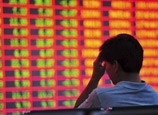
China's economic growth will pick up in the third quarter despite the recent liquidity crunch, and the government's full-year target of 7.5 percent expansion can be achieved, Bank of China Ltd said in a quarterly report on Wednesday.
The GDP growth rate will reach 7.8 percent in the third quarter, with 7.6 percent growth for the second half overall, according to the report.
The first-quarter expansion of the world's second-largest economy moderated to 7.7 percent amid sluggish external demand and soft investment.
"Acceleration of urbanization, a rally in consumption, an export recovery and base factors will support economic stability in the coming months," the bank said.
It added that if any new stimulus policy is introduced this year, growth might even reach 8 percent.
The report noted that manufacturers have nearly ended de-stocking and industrial output is expected to rise by 9.5 percent in the third quarter, slightly faster than in the second quarter.
But increased unemployment and financial risks such as shadow banking, local government debts and rising bad loans call for precautions, said Zhou Jingtong, a senior analyst at BOC.
"Employment is a lagging indictor for the overall economy. As exports dive, we forecast deterioration in unemployment if the economy continues to falter, which calls for an increased role for fiscal policy."
Investment in infrastructure may help the economy recover in 2013, with fixed-asset investment in infrastructure up some 30 percent year-on-year in the first half, said Pu Yonghao, regional chief investment officer for Asia Pacific at UBS Wealth Management.
"However, China's economic growth may continue to slow in the second half of 2013, according to statistics for power consumption and freight loading, which measure real economy activities," Pu said.
Exports in the second half may not help, while the real estate industry faces critical challenges, he said.
Several financial institutions have cut their forecasts for China's 2013 and 2014 growth amid the worst cash crunch in the interbank market in nearly a decade.
Cao Yuanzheng, chief economist of BOC, said the liquidity problems are temporary and won't affect the real economy that much, though they will affect banks' financing costs.
Pu said the causes of the liquidity crunch include a narrowing trade surplus, reflecting less active exports, and an aging population that is drawing down savings to cover living expenses.
Low funding costs in recent years have led to overcapacity and speculation, and the current move to bring funding costs to reasonable levels are also an attempt to squeeze overcapacity and speculation out, he said.
Cao said the most practical way to strike a balance between curbing off-balance-sheet lending expansion and supporting economic growth is to securitize the shadow banking assets and float them transparently in the market.
Policy stability
The State Council on Wednesday reiterated that current economic policies will be maintained, the Xinhua News Agency reported.
China's economic situation is generally stable this year, and the government can steadily proceed with moves to balance short-term growth and structural adjustment.
The meeting focused on accelerating urban redevelopment as a means of driving investment and consumption.
The council said 10 million dwellings in rundown urban areas will be renovated over the next five years.
















 Wait and See!
Wait and See!
I can catch you, rats


![]()
